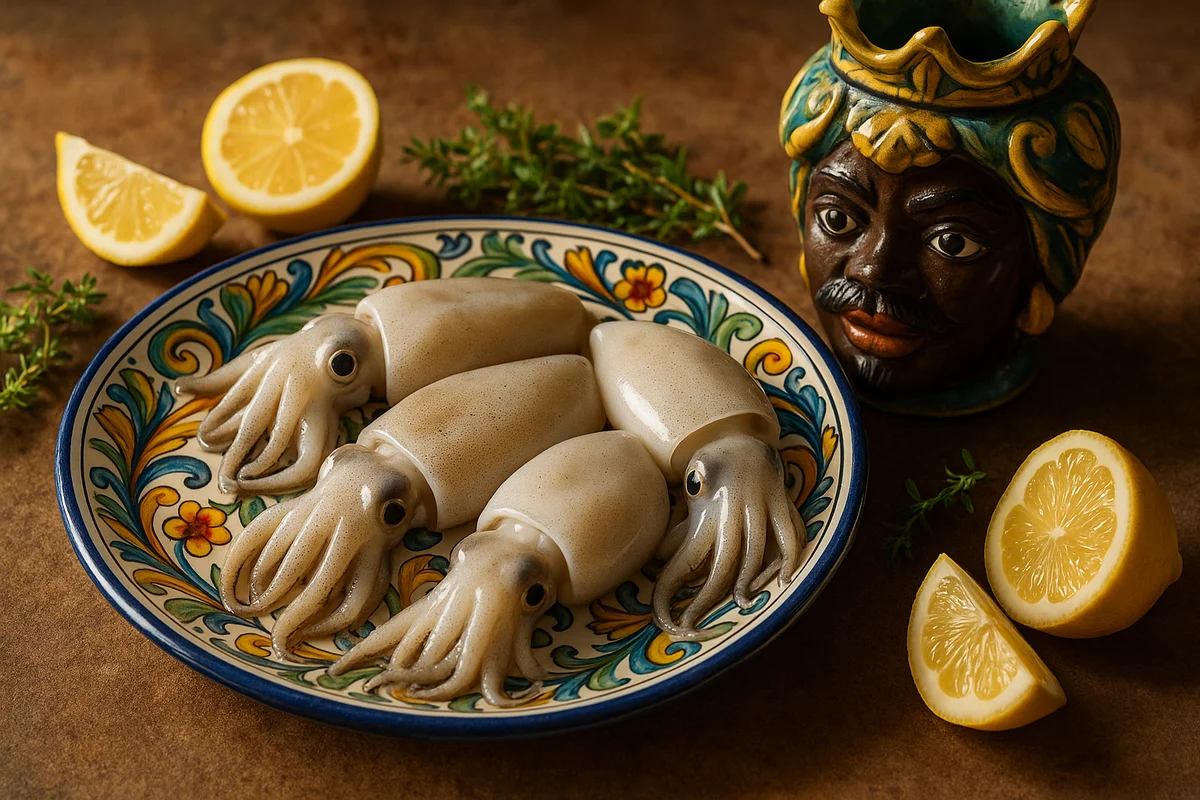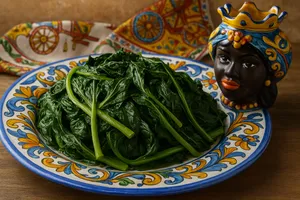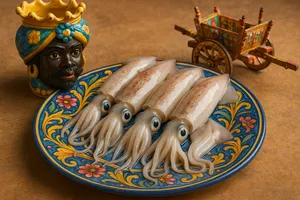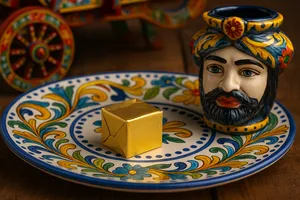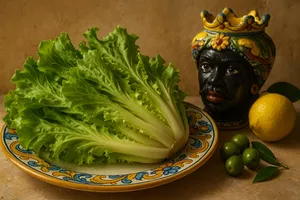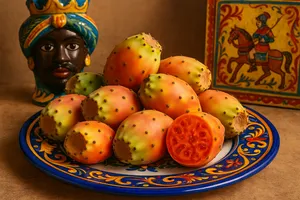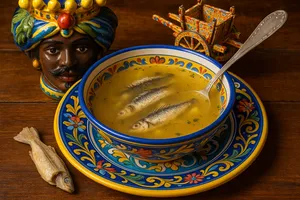Overview
Cuttlefish, known in Sicilian as “sicci” or “sicce”, are cephalopod molluscs belonging to the order Sepiida, characterised by an oval flattened body, a fleshy mantle, eight short tentacles and two longer retractable tentacles used to capture prey, as well as an internal calcareous bone (the cuttlebone, traditionally given to caged birds as a source of calcium), and a black ink sac used for defence and in cooking. They live on the sandy and muddy seabeds of the Mediterranean, where they camouflage themselves perfectly by changing colour. In Sicilian cuisine, cuttlefish are highly appreciated, starring in iconic preparations: cuttlefish in black ink (using their ink), stuffed cuttlefish, grilled cuttlefish, stewed cuttlefish with peas, fried cuttlefish. Their flesh is tender when cooked correctly, delicately flavoured and versatile.
Cuttlefish fishing in Sicilian waters is a traditional activity carried out with nets, traps and the “totanara” technique (a luminous lure used at night to attract cuttlefish). Freshly caught cuttlefish have firm flesh, a bright colour and a delicate marine fragrance. They require thorough cleaning to remove the innards, bone and ink sac (which is kept separately for certain recipes). Distinguishing between different sizes is important: small cuttlefish (seppioline) are perfect for frying, medium ones for stuffing and stews, large ones for grilling. Every Sicilian who loves the sea has memories tied to cuttlefish: the meticulous cleaning that stains the hands with ink, the delicate flavour of fresh flesh, the dramatic black ink that colours pasta and risottos. Cuttlefish represent authentic coastal cooking—patience in preparation and a celebration of the Mediterranean’s bounty.
Characteristics
Cuttlefish have an oval body flattened dorsally and ventrally (unlike squid, which are cylindrical), with a fleshy mantle 10–40 cm long (common sizes are 15–25 cm), and a colour that varies from whitish-grey to reddish-brown with speckles (they can change colour for camouflage). They have lateral fins running along the entire body (creating an almost continuous border), eight short tentacles with suckers, and two long retractable tentacles with suckers only at the terminal part (used to catch prey).
Inside the mantle are the cuttlebone (a light, porous, white calcareous internal shell), the ink sac (intensely black, viscous liquid) and the internal organs. The flesh is white, tender when cooked properly (it can become rubbery if poorly cooked or overcooked), with a delicate, slightly sweet marine flavour. The aroma should be fresh and never ammoniacal.
Fresh cuttlefish have a firm, elastic mantle, bright eyes, vivid colouring and a delicate scent of the sea. Older cuttlefish have a flaccid mantle, dull eyes, a strong unpleasant odour and skin that detaches easily.
Cuttlefish vs squid vs flying squid
These cephalopods are often confused but have differences:
Cuttlefish: Oval flattened body, fins along the entire body, internal calcareous bone, abundant ink sac. Tender flesh, delicate flavour. Live on seabeds.
Squid: Elongated cylindrical torpedo-shaped body, triangular fins only at the terminal part, a transparent cartilaginous “pen” (gladius), small ink sac. Tender flesh, delicate flavour. Swim in open waters.
Flying squid: Similar to squid but larger, with a robust body, rhomboid terminal fins and firmer flesh (requiring either long cooking or very short high-heat cooking to avoid toughness). Live in deeper waters.
All three are fished and cooked in Sicily, but cuttlefish have a special place thanks to their versatility and the ink used in cooking.
Fishing and seasonality
Cuttlefish live on sandy and muddy coastal seabeds, from a few metres down to 200 metres. They are predators feeding on fish, crustaceans and molluscs. They have extraordinary camouflage abilities: they change colour and skin texture to blend into their surroundings.
They are caught with set nets, trammel nets, traps, trawls and with totanare (artificial lures with multiple hooks, often luminous for night fishing). Traditional Sicilian cuttlefish fishing is practised year-round with seasonal peaks.
The optimal seasons are spring (March–May), when cuttlefish approach the coast to reproduce, and autumn (September–November). In these periods they are more abundant and of better quality. In summer they may be less common.
Cleaning cuttlefish
Cleaning cuttlefish requires practice but is not difficult:
1. Detach the tentacles from the mantle by gently pulling (they come away together with the internal organs).
2. Remove the cuttlebone from the mantle (located on the dorsal side; it slides out easily).
3. Identify the ink sac (a small silvery sac among the organs) and set it aside if you wish to use it (taking care not to break it), otherwise discard it with the organs.
4. Rinse the inside of the mantle under running water to remove any residue.
5. Remove the outer skin from the mantle (it peels off easily, reddish-brown and speckled). This step is optional: the skin is edible, though some prefer removing it for a cleaner appearance.
6. From the tentacles: remove the eyes (cut just above them) and remove the “beak” (the hard mouth at the centre of the tentacles; squeeze to extract it).
7. Rinse everything thoroughly under water.
8. The mantle and tentacles are ready to be cooked whole, cut into pieces, rings, or stuffed.
The hands stain black during cleaning (from ink leakage): this is normal. It washes off with water and soap (lemon helps).
Culinary uses in Sicilian cooking
Cuttlefish in black ink
An iconic dish: cuttlefish cut into pieces and stewed with tomato, garlic, white wine and their ink, which colours everything a deep black. Served with bread or used to dress pasta or risotto. The flavour is deep, marine and characteristic.
Stuffed cuttlefish
The mantle is filled with a stuffing of breadcrumbs, minced tentacles, parsley, garlic, eggs, pecorino, pine nuts (variations exist), sewn or secured with toothpicks, and cooked in tomato sauce or baked. A traditional, elegant preparation.
Grilled cuttlefish
Whole cuttlefish or those halved are grilled over coals or on a griddle, seasoned with oil, garlic, parsley and lemon. Quick cooking keeps them tender. Served hot.
Fried cuttlefish
Small cuttlefish or cuttlefish cut into rings are floured and fried in hot oil. They become crisp and golden. Delicious with lemon, and a classic element of mixed fried seafood.
Cuttlefish with peas
Cuttlefish cut into pieces stewed with fresh peas, onion, tomato and white wine. A traditional springtime dish, balanced and flavourful.
Seafood salad with cuttlefish
Boiled cuttlefish cut into pieces mixed with other seafood (octopus, prawns, mussels), celery, lemon, oil and parsley. A fresh summer starter.
Pasta with cuttlefish ink
Pasta (spaghetti, linguine) dressed with a sauce made with cuttlefish and their ink. The pasta turns black—spectacular and full of flavour.
Stewed cuttlefish
Cuttlefish slowly cooked in a pan with tomato, garlic, white wine and parsley. Served with the sauce, accompanied by bread or polenta.
Cuttlefish ink
Cuttlefish ink is a precious ingredient. It has an intense marine, salty, slightly metallic flavour. It is used to colour and flavour pasta, risottos and sauces. It is rich in melanin (the black pigment), proteins and minerals.
To use fresh ink: carefully break the silvery sac collected during cleaning into a small bowl with a little water or wine, and mix to dilute. Add to the sauce during cooking. Ink can also be purchased ready-made in sachets (convenient but less fresh).
The ink stains permanently: take care with clothing and surfaces. Teeth turn temporarily black after eating ink-based dishes (an amusing effect for those unaware).
Perfect cooking of cuttlefish
Cuttlefish require either very brief high-heat cooking (frying, quick grilling, 2–3 minutes) or long gentle cooking (stews, 30–45 minutes or more). Intermediate cooking times (10–20 minutes at medium heat) make them rubbery.
For tender cuttlefish in stews: cook gently, covered, for at least 30–40 minutes. With long cooking, the fibres relax and the flesh becomes very soft. Add liquids (wine, broth, tomato) as needed to prevent drying out.
Very large cuttlefish may need tenderising (lightly pounding with a meat mallet) before cooking.
Storage
Fresh cuttlefish should be kept in the refrigerator, in the coldest part, on ice, for no more than 1–2 days. They must be consumed very fresh.
Cleaned raw cuttlefish keep slightly better than whole ones, but still only for 1–2 days.
Cooked cuttlefish keep in the refrigerator for 2–3 days in a sealed container.
Cuttlefish can be frozen: cleaned, in airtight bags or vacuum-sealed, they keep for 2–3 months. Thaw slowly in the refrigerator and cook immediately. Freezing slightly reduces tenderness but is acceptable.
Purchase tips
Choose fresh (not frozen) cuttlefish when available. Check freshness: a firm, elastic mantle, bright eyes, vivid colouring, delicate marine aroma. Avoid cuttlefish with a flaccid mantle, dull eyes, a strong ammoniacal odour or detaching skin.
Size depends on intended use: small (5–10 cm) for frying, medium (15–20 cm) for stews and stuffing, large (25–30 cm) for grilling or cutting into pieces.
Ask the fishmonger to clean them if you are not experienced: many do so for free or for a small fee. Keep the ink if you wish to use it.
In Sicily, fresh cuttlefish can be found in coastal fish markets. Prices vary (10–20 euros/kg) depending on season, size and freshness.
Nutritional properties
Cuttlefish are lean and protein-rich: 100 g of flesh provides about 80–90 calories. They contain 16–18 g of high-quality protein, 1–2 g of fat and zero carbohydrates. They are rich in B vitamins (especially B12), vitamin E and minerals such as selenium, phosphorus, potassium, zinc, iron, iodine and copper.
They are easily digestible and suitable for low-calorie diets. The proteins are complete. Selenium has antioxidant properties. Like all molluscs, they contain moderate cholesterol (about 100–150 mg per 100 g).
Cuttlefish ink contains melanin, proteins and minerals, and has antioxidant properties studied by modern science.
Cuttlefish in Sicilian tradition
Cuttlefish have always had an important place in Sicilian coastal cooking. Cuttlefish fishing was (and is) practised by coastal fishermen who know the seabeds and habits of these molluscs.
Stuffed cuttlefish were a festive dish, prepared for special occasions to make an impression. They required time (cleaning, preparing the filling, cooking), making them a sign of dedication.
Cuttlefish ink was used not only in cooking but also as writing ink (“seppia” is the root of the word for ink in some languages). It was a precious resource—nothing was wasted.
Curiosities
Cuttlefish are among the most intelligent invertebrates. They have a complex brain, memory, learning ability and problem-solving skills. They can communicate by changing colour and patterns on their skin.
Their camouflage is extraordinary: they not only change colour but also alter skin texture, creating bumps to mimic algae, rocks or sand. This formidable evolutionary adaptation aids both hunting and defence.
The cuttlebone is traditionally given to caged birds (canaries, parrots) as a calcium source for beak and bone health. It is an ancient practice still used today.
The term “sepia” for the reddish-brown colour derives from the ink and skin of these molluscs. The “sepia” tone in old photographs recalls the natural hues of diluted ink.
Cuttlefish have three hearts: two branchial hearts (pumping blood to the gills for oxygenation) and one systemic heart (pumping oxygenated blood to the rest of the body). Their blood is blue-green due to haemocyanin (a copper-based protein) instead of haemoglobin (iron-based).
Cuttlefish have a short lifespan (1–2 years). They grow rapidly, reproduce and die. This reproductive strategy (semelparity in many species) is characteristic of many cephalopods.
In Sicilian popular speech, “fari 'u niru comu 'na siccia” (“to make black like a cuttlefish”) means to sulk or pout, referring to the dark colour cuttlefish assume when irritated or frightened.

